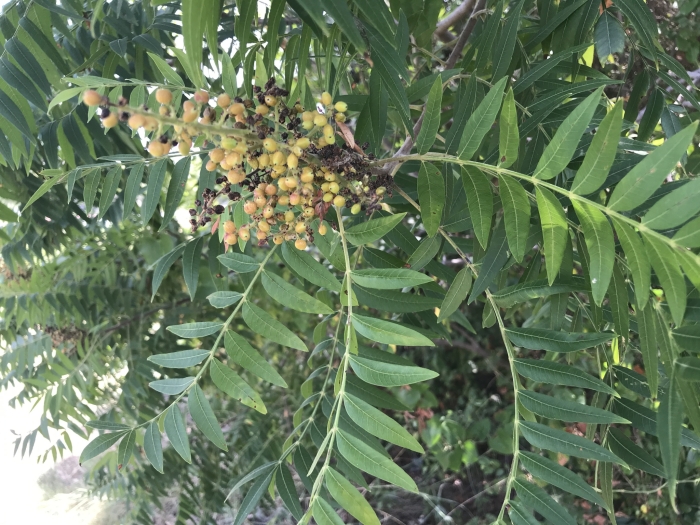Prairie Sumac
(Rhus lanceolata)
Prairie Sumac (Rhus lanceolata)
/
/

Victor Engel
CC BY 4.0
Image By:
Victor Engel
Recorded By:
Copyright:
CC BY 4.0
Copyright Notice:
Photo by: Victor Engel | License Type: CC BY 4.0 | License URL: http://creativecommons.org/licenses/by/4.0/ | Rights Holder: Victor Engel | Publisher: iNaturalist | Date Created: 2021-09-05T19:47:18Z |





















































Estimated Native Range
Summary
Rhus lanceolata, commonly known as Prairie Sumac, is a deciduous shrub native to the prairies, open woodlands, and riparian zones of the South Central United States and Mexico. It typically grows up to 9 meters (30 feet) tall and can spread widely due to its underground rhizomes. Prairie Sumac has a rounded form with compound leaves that turn a striking red or orange in the fall. The flowers, borne in panicles up to 14 cm (5.6 inches) tall, are white to greenish and bloom in the spring to early summer. They are followed by lens-shaped, dark red, hairy fruits about 6 mm (0.25 inches) across, which are consumed by birds during the winter, while deer forage on the foliage.
Prairie Sumac is valued for its drought tolerance and ability to stabilize soil, making it suitable for erosion control and naturalistic plantings. It is also used in wildlife gardens due to its appeal to birds and other fauna. This species thrives in part shade to full sun, with low to medium water requirements, and prefers well-drained soils. While it is generally low-maintenance, it can spread aggressively via rhizomes, which should be considered when planting in smaller areas or near garden borders.CC BY-SA 4.0
Prairie Sumac is valued for its drought tolerance and ability to stabilize soil, making it suitable for erosion control and naturalistic plantings. It is also used in wildlife gardens due to its appeal to birds and other fauna. This species thrives in part shade to full sun, with low to medium water requirements, and prefers well-drained soils. While it is generally low-maintenance, it can spread aggressively via rhizomes, which should be considered when planting in smaller areas or near garden borders.CC BY-SA 4.0
Plant Description
- Plant Type: Shrub, Tree
- Height: 12-20 feet
- Width: 15-20 feet
- Growth Rate: Moderate
- Flower Color: White
- Flowering Season: Summer
- Leaf Retention: Deciduous
Growth Requirements
- Sun: Full Sun, Part Shade
- Water: Medium
- Drainage: Fast, Medium
Common Uses
Bee Garden, Bird Garden, Butterfly Garden, Deer Resistant, Drought Tolerant, Fragrant, Hummingbird Garden, Low Maintenance, Rabbit Resistant, Street Planting
Natural Habitat
Prairies, open woodlands, and riparian zones
Other Names
Common Names:
Scientific Names: Rhus lanceolata , Rhus copallinum var. lanceolata , Rhus copallina var. lanceolata , Schmaltzia lanceolata , Schmalzia lanceolata
GBIF Accepted Name: Rhus lanceolata (Gray) Britton